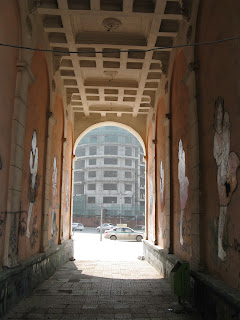First up, street art of Ulaanbaatar!
Girl with skateboard, archway immediately west of the National University of Mongolia's central building
Here she is (second from left) with some of her sisters and some decidedly less glorious graffiti
All eight girls with skateboards, view towards the southeast
Girl with skateboard, best-dressed of the eight sisters. Notice the Christopher Nolan Joker amongst the other cartoon faces.
Narrative panel, east of the Chinggis Hotel and Sky Department Store in Sansar. Reading left to right, this piece seems to communicate the elevating influence of three different factors - vodka, weed, and love - on the human experience. Love may give you wings but weed apparently keeps you serene in the face of belligerent drunks.
Three legendary figures (and two live participants), east of the Chinggis Hotel and Sky Department Store in Sansar. My best guess is that these are three characters from the Chinese classic 'Journey to the West'. Maybe?
Left figure: maybe the Monkey King? He looks pretty psyched about that staff.
Center figure: Zhu Bajie or 'Pigsy' maybe? The censors clearly came along later and spray-painted that man-ssiere (or bro) on him.
Right figure: hmm, maybe this is the Monkey King? I don't know my Chinese classics. Of course, these figures could be something else entirely.
Ulaanbaatar seems to have a flourishing art scene and a number of excellent small galleries showing a variety of new work. Others know more about this, so please feel free to leave a comment (attn: Teresa). On Thursday, August 15th, the 976 gallery had an opening for several talented young artists. We were lucky enough to attend and cameras were encouraged:
The featured artist was a young man named Otgontuvden and his works made up the majority of the exhibition:
Boy with Lamb (perhaps not the actual title)
Lama (Monk). This portrait reminds me of Rembrandt, almost like a combination between some of his self-portraits as he grew older and his 'Philosopher in Meditation'.
The overall impression is one of vitality and conflict generated by the interactions between the men as well as the horses. (Notice the band playing in the bottom left corner)
In 2011, I was fortunate enough to visit an art's guild in Ulaanbaatar and get a tour of a number of individual artist's studio. While Otgontuvden is young, his style is highly reminiscent of the works produced by some of the older painters in that guild. However, Otgontuvden's choices regarding composition and subject matter really differentiate him from what I perceive to be an older school of Mongolian oil painting.
Khishigsuren is another young artist showing only three pieces at 976 that seemed of a more Impressionist bent than anything I've seen in Mongolia. However, like Otgotuvden, Khishigsurn appears to favor pastoral nomadic and traditional Mongolian themes:
Sunny Rain
Naadam
Last but not least were the spectacular works of Nomin:
If the other two featured artists work with pastoral nomadic motifs, Nomin delves heavily into Mongolian history and Buddhism in this exhibition. In the above photo, the picture on the left is a procession of women in Mongol Imperial royal garb. I've seen Yuan Dynasty portraiture of Chinggisid queens and princesses in similar attire:
(Detail of painting on left)
The picture on the right is much more detailed:
Om Mani Pad Me Om. Aside from the royal processional, most of Nomin's paintings displayed at this exhibition featured this puppet-strings motif (you can make out the control bars clustered at the very top of the painting and then trace the strings down to each figure). The dizzingly complex scene depicted here is set in the Mongolian Buddhist pantheon. Not being a scholar of Mongolian Buddhism, I have nothing to add except selected close-ups:
Another of Nomin's paintings with Mongolian Buddhist themes and motifs:
Some of my favorite details from the above work:
To close out the post, a figure who should be familiar to many readers:
Boba Fett didn't die in the sarlacc pit, he just lost a few limbs. Somebody get him a tourniquet, stat!




























No comments:
Post a Comment